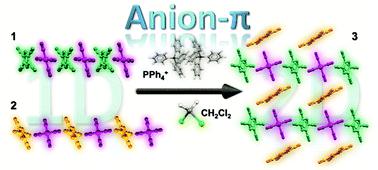当前位置:
X-MOL 学术
›
Inorg. Chem. Front.
›
论文详情
Our official English website, www.x-mol.net, welcomes your feedback! (Note: you will need to create a separate account there.)
A concerted evolution of supramolecular interactions in a {cation; metal complex; π-acid; solvent} anion-π system
Inorganic Chemistry Frontiers ( IF 7 ) Pub Date : 2020-03-10 , DOI: 10.1039/d0qi00101e Emilia Kuzniak 1, 2, 3, 4 , James Hooper 1, 2, 3, 4 , Monika Srebro-Hooper 1, 2, 3, 4 , Jedrzej Kobylarczyk 1, 2, 3, 4 , Magdalena Dziurka 1, 2, 3, 4 , Bogdan Musielak 1, 2, 3, 4 , Dawid Pinkowicz 1, 2, 3, 4 , Jesus Raya 5, 6, 7, 8, 9 , Sylvie Ferlay 10, 11, 12, 13 , Robert Podgajny 1, 2, 3, 4
Inorganic Chemistry Frontiers ( IF 7 ) Pub Date : 2020-03-10 , DOI: 10.1039/d0qi00101e Emilia Kuzniak 1, 2, 3, 4 , James Hooper 1, 2, 3, 4 , Monika Srebro-Hooper 1, 2, 3, 4 , Jedrzej Kobylarczyk 1, 2, 3, 4 , Magdalena Dziurka 1, 2, 3, 4 , Bogdan Musielak 1, 2, 3, 4 , Dawid Pinkowicz 1, 2, 3, 4 , Jesus Raya 5, 6, 7, 8, 9 , Sylvie Ferlay 10, 11, 12, 13 , Robert Podgajny 1, 2, 3, 4
Affiliation

|
Combined Single-Crystal XRD, solution 13C and 195Pt NMR, solid-state 195Pt NMR and UV-vis measurements, together with comprehensive (TD)DFT calculations, are used to describe the supramolecular interactions and sequential concerted structural transformation occurring in a {PPh4+;[Pt(CN)4]2−;TCP;CH2Cl2} supramolecular system (TCP – tetracyanopyrazine). In the solid-state, a mixture of needle-like co-crystals first appears, (PPh4)2{[TCP][Pt(CN)4]} (1) and (PPh4)2{[TCP][Pt(CN)4]}·2CH2Cl2 (2), and subsequent recrystallization leads to block-shaped co-crystals of (PPh4)2{[TCP]2[Pt(CN)4]}·2CH2Cl2 (3), wherein double {[Pt(CN)4]2−;TCP} and triple {[Pt(CN)4]2−;TCP;CH2Cl2} and {PPh4+;[Pt(CN)4]2−;TCP} synthons present either in 1 or 2 are reproduced in 3. The structural pathway (1,2→3) is accompanied by a 1D-to-2D modular evolution of anion-π interactions between [Pt(CN)4]2− and π-acidic TCP that seems to be driven, as indicated by calculations, not by maximizing their strength but rather by optimizing other crystal interactions, e.g. between PPh4+ cations. Formation of the corresponding {[Pt(CN)4]2−;π-acid} anion-π contacts in solution is evidenced by 13C NMR shifts and by new low-energy electronic absorption in the visible region (UV-vis). Finally, a combined solution/solid-state 195Pt NMR approach is used for the first time to shed light on the geometry and interactions involving such aggregates; it shows that the degree of trapping of [Pt(CN)4]2− near a π-acidic surface can be monitored by 195Pt NMR chemical shifts. The results give fresh insight into block arrangement tactics and characterization of hybrid organic-inorganic co-crystal salts, and into aggregation controlled properties.
中文翻译:

阳离子中超分子相互作用的协同进化 金属络合物 π-酸; 溶剂}阴离子-π体系
结合使用单晶XRD,溶液13 C和195 Pt NMR,固态195 Pt NMR和UV-vis测量以及全面的(TD)DFT计算,可描述超分子相互作用和相继发生的一致结构转变。 {PPh 4 + ; [Pt(CN)4 ] 2− ; TCP; CH 2 Cl 2 }超分子体系(TCP –四氰基吡嗪)。在固态下,首先出现针状共晶体的混合物,(PPh 4)2 {[TCP] [Pt(CN)4 ]}(1)和(PPh 4)2{[TCP] [Pt(CN)4 ]}·2CH 2 Cl 2(2),然后进行重结晶,得到(PPh 4)2 {[TCP] 2 [Pt(CN)4 ]的块状共晶体。}·2CH 2 Cl 2(3),其中双{[Pt(CN)4 ] 2- ; TCP}和三重{[Pt(CN)4 ] 2- -TCP; CH 2 Cl 2 }和{PPh 4 + ; [Pt(CN)4 ] 2- ;; TCP}合成子以1或2形式存在复制于3。结构途径(1,2 → 3)伴随之间阴离子-π相互作用的1D到2D模块化进化[PT(CN)4 ] 2-和π酸性TCP似乎被驱动,由所指示的通过计算,不是通过最大化其强度,而是通过优化其他晶体相互作用,例如PPh 4 +阳离子之间的相互作用。溶液中相应的{[Pt(CN)4 ] 2 ;;π-酸}阴离子-π接触的形成由13证明。在可见光区域(紫外可见光),C NMR发生位移并通过新的低能电子吸收而移动。最后,首次使用溶液/固态195 Pt NMR组合方法首次阐明了涉及此类聚集体的几何形状和相互作用。结果表明,通过195 Pt NMR化学位移可以监测π-酸性表面附近[Pt(CN)4 ] 2-的俘获程度。结果提供了新的见解,以块排列策略和有机有机-无机共晶体杂化盐的表征,以及聚集控制的性质。
更新日期:2020-03-10
中文翻译:

阳离子中超分子相互作用的协同进化 金属络合物 π-酸; 溶剂}阴离子-π体系
结合使用单晶XRD,溶液13 C和195 Pt NMR,固态195 Pt NMR和UV-vis测量以及全面的(TD)DFT计算,可描述超分子相互作用和相继发生的一致结构转变。 {PPh 4 + ; [Pt(CN)4 ] 2− ; TCP; CH 2 Cl 2 }超分子体系(TCP –四氰基吡嗪)。在固态下,首先出现针状共晶体的混合物,(PPh 4)2 {[TCP] [Pt(CN)4 ]}(1)和(PPh 4)2{[TCP] [Pt(CN)4 ]}·2CH 2 Cl 2(2),然后进行重结晶,得到(PPh 4)2 {[TCP] 2 [Pt(CN)4 ]的块状共晶体。}·2CH 2 Cl 2(3),其中双{[Pt(CN)4 ] 2- ; TCP}和三重{[Pt(CN)4 ] 2- -TCP; CH 2 Cl 2 }和{PPh 4 + ; [Pt(CN)4 ] 2- ;; TCP}合成子以1或2形式存在复制于3。结构途径(1,2 → 3)伴随之间阴离子-π相互作用的1D到2D模块化进化[PT(CN)4 ] 2-和π酸性TCP似乎被驱动,由所指示的通过计算,不是通过最大化其强度,而是通过优化其他晶体相互作用,例如PPh 4 +阳离子之间的相互作用。溶液中相应的{[Pt(CN)4 ] 2 ;;π-酸}阴离子-π接触的形成由13证明。在可见光区域(紫外可见光),C NMR发生位移并通过新的低能电子吸收而移动。最后,首次使用溶液/固态195 Pt NMR组合方法首次阐明了涉及此类聚集体的几何形状和相互作用。结果表明,通过195 Pt NMR化学位移可以监测π-酸性表面附近[Pt(CN)4 ] 2-的俘获程度。结果提供了新的见解,以块排列策略和有机有机-无机共晶体杂化盐的表征,以及聚集控制的性质。



























 京公网安备 11010802027423号
京公网安备 11010802027423号